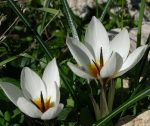 Native to rocky areas and undergrowth of Israel, Lebanon, Palestine, and Syria, this perennial corm is a member of the iris family, Iridaceae, that also includes gladiolus, crocosmia, and blue-eyed grass. The plant grows 1-3″ tall and has a rosette of grass-like leaves with a central white line along the leaf axis. The solitary cup-shaped flowers appear from November to February and have a white perianth of 6 parts that are fused and feature a yellow blotch in the center with 3 conspicuous purple-black stamens. Photo Credit Wikipedia
Native to rocky areas and undergrowth of Israel, Lebanon, Palestine, and Syria, this perennial corm is a member of the iris family, Iridaceae, that also includes gladiolus, crocosmia, and blue-eyed grass. The plant grows 1-3″ tall and has a rosette of grass-like leaves with a central white line along the leaf axis. The solitary cup-shaped flowers appear from November to February and have a white perianth of 6 parts that are fused and feature a yellow blotch in the center with 3 conspicuous purple-black stamens. Photo Credit Wikipedia
There are 15 or more kinds of crocuses in the Holy Land. Four of these grow in alpine and subalpine regions and rocky places in the mountains of Lebanon (as well as elsewhere) which is a significant factor when considering Song of Song 6:4. In this passage a lover is comparing his beloved to cities but some authorities think that flowers are actually meant. Four flowers are suggested for the city Tirzah due to their presence in the area that inspired the writing of the passage . Winter crocus (C. hyemalis) is one of them. The others are: Crocus cancellatus var. damascenus, C. vitellinus, and C. zonatus (see entries for each of these species for further information). Winter crocuses appears in winter during the rainy season and resemble candles reminiscent of Hanukkah, the Festival of Lights.
Song of Songs 6:4 (NIV)
“You are as beautiful as Tirzah, my darling, as lovely as Jerusalem, as majestic as troops with banners.”
Winter crocus like full sun and average, medium moist, gritty sandy, well-drained soil in USDA Hardiness Zones 8 and warmer. Propagation is by division of offsets. Plants spring up in winter when little else blooms and is a good choice for rock or gravel gardens.
The genus name, Crocus, is from the Greek word κρόκος ( krokos), meaning thread and refers to the appearance of the stigmas. The specific epithet, hyemalis, is the Latin word meaning wintery, and refers to the time of flowering.